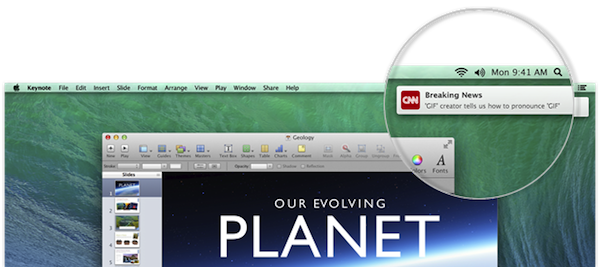
Back in June, Apple announced its new version of OS X for Macs, which goes by the name Mavericks. One of the less noticed features was something called Safari Push Notifications, which promises to allow websites on Macs to do what apps on phones can:
Interrupt you.
(In the best possible sense of interruption, of course.)
For news organizations, those interruptions come primarily through the breaking news notifications you probably get from your favorite news organizations. We’re in an era when news consumption is less about discrete times — reading your newspaper at the breakfast table, watching Walter Cronkite at 6:30 — and more about digital news seeping into the nooks and crannies of your day. In that context, smart notifications are critical to news organizations’ efforts to reach their audience where they are.
Today, Apple released Mavericks and announced that, unlike previous major updates, it’s free — which will help its adoption rate. And we’re already seeing the first news organizations taking advantage of the opportunity. MacRumors noticed last night that The New York Times, among other sites, was on board. In its demo today, Apple showed off Major League Baseball sending alerts for scores. On its preview page, Apple shows a CNN desktop alert.
What do you need to know about Safari notifications?
This file, for example, is the JavaScript that powers NBA.com’s instance of Safari notifications. You can see The New York Times’ code at the bottom of this file.
On their own, Safari Push Notifications won’t revolutionize anything. I suspect many American news sites have audience shares like Talking Points Memo’s, which on Sunday noted that around 23 percent of its audience is on Macs, but only a minority of those are using Safari. (I’m a Chrome/Mac guy myself.) Further slice that crowd to include only those who’ve upgraded to Mavericks and you’re looking at under 5 percent of users at most sites for the near future.
But Chrome has its own notifications system (although one I understand is not as developer-friendly as Apple’s — but I haven’t tried it out). More systems will follow, and — hopefully! — someone like Push.io can do the job of abstracting a method of triggering all of them at once. And while the number of readers who use Macs and upgrade to the latest software is small, they’re also disproportionately the sort that spends a lot of time and money online.
I think this is a big deal. We know that a lot of digital news consumption happens at work. And we know that, for many people who want to keep up with the latest news, Twitter or some other social network is probably the best way to do that in real time. (Twitter’s “experiment” with @EventParrot shows they’re well aware of the power of news push notifications.)
Safari push and what will follow it promise a way for the nowness of breaking news to be transferred to the desktop environment — but with the relationship being directly between the news organization and the audience. Add the possibilities of personalization — interrupting me with only the news I’m really interested in — and you have the sort of high-value feature that can build loyalty.
I’m sure there’ll be some growing pains along the way — people who commit to too many notifications and get overwhelmed, for one. But even through the momentum is all in favor of mobile, people will still get a lot of news at their desks for the foreseeable future. And this shift will help news organizations reap a little bit more of the benefits.